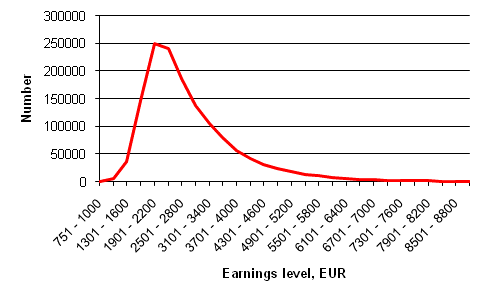Published: 9 April 2010
Pay differentials continued to grow in 2008
According to Statistics Finland’s Structure of Earnings statistics, the average monthly earnings of all full-time wage and salary earners were EUR 2,876 in the last quarter of 2008 and the median 1) earnings were EUR 2,551. The earnings of the best paid tenth (9th decile) of wage and salary earners exceeded EUR 4,287 while the lowest paid tenth (1st decile) earned less than EUR 1,826 per month. Thus, the best paid decile earned at least 2.35 times more than the decile with the lowest earnings. The difference in earnings between the highest and the lowest decile grew by around three percentage points from the previous year.
Distribution of monthly earnings of full-time wage and salary earners in 2008

The main reason for the observed growth in pay differentials was that the earnings of well-paid wage and salary earners developed faster than average in 2008. The rising of the earnings of the best paid wage and salary earners speeded up especially because the number of wage and salary earners fell in performing tasks with medium pay. While the earnings of the best paid decile rose by 5.9 per cent in the year, the earning of the lowest paid decile only went up by 4.5 per cent over the same time period.
Despite the growth of the pay differentials at the general level, the gender pay gap narrowed in 2008 (see data released from Structure of Earnings statistics on 6 November 2009). The narrowing of the gender pay gap is explained by both a change in the structure of the wage and salary earning population and better development of women’s than men’s earnings in 2008. In the 2008 Structure of Earnings statistics the changed structure of the wage and salary earning population showed as a reduced number of full-time wage and salary earning men in manufacturing. The improved coverage of the private services sector and the local government sector in the Structure of Earnings statistics was also one reason why women’ earnings showed faster development than men’s.
These data derive from Statistics Finland’s Structure of Earnings statistics, which cover all employer sectors. Monthly earnings for total hours worked are only calculated for full-time wage and salary earners. Besides earnings for regular working hours, the earnings also include pay for any possible overtime and working hour supplements but not one-off performance-based bonuses.
1) Fifty per cent of wage and salary earners earn more and fifty per cent less than the median earnings.
Source: Structure of Earnings 2008, Statistics Finland
Inquiries: Antti Katainen (09) 1734 2347, Mika Idman (09) 1734 3445, palkkarakenne@stat.fi
Director in charge: Kari Molnar
Publication in pdf-format (229.2 kB)
- Reviews
- Tables
-
Tables in databases
Pick the data you need into tables, view the data as graphs, or download the data for your use.
Appendix tables
Updated 9.4.2010
Official Statistics of Finland (OSF):
Structure of Earnings [e-publication].
ISSN=1799-0092. 2008. Helsinki: Statistics Finland [referred: 5.1.2026].
Access method: http://stat.fi/til/pra/2008/pra_2008_2010-04-09_tie_001_en.html

